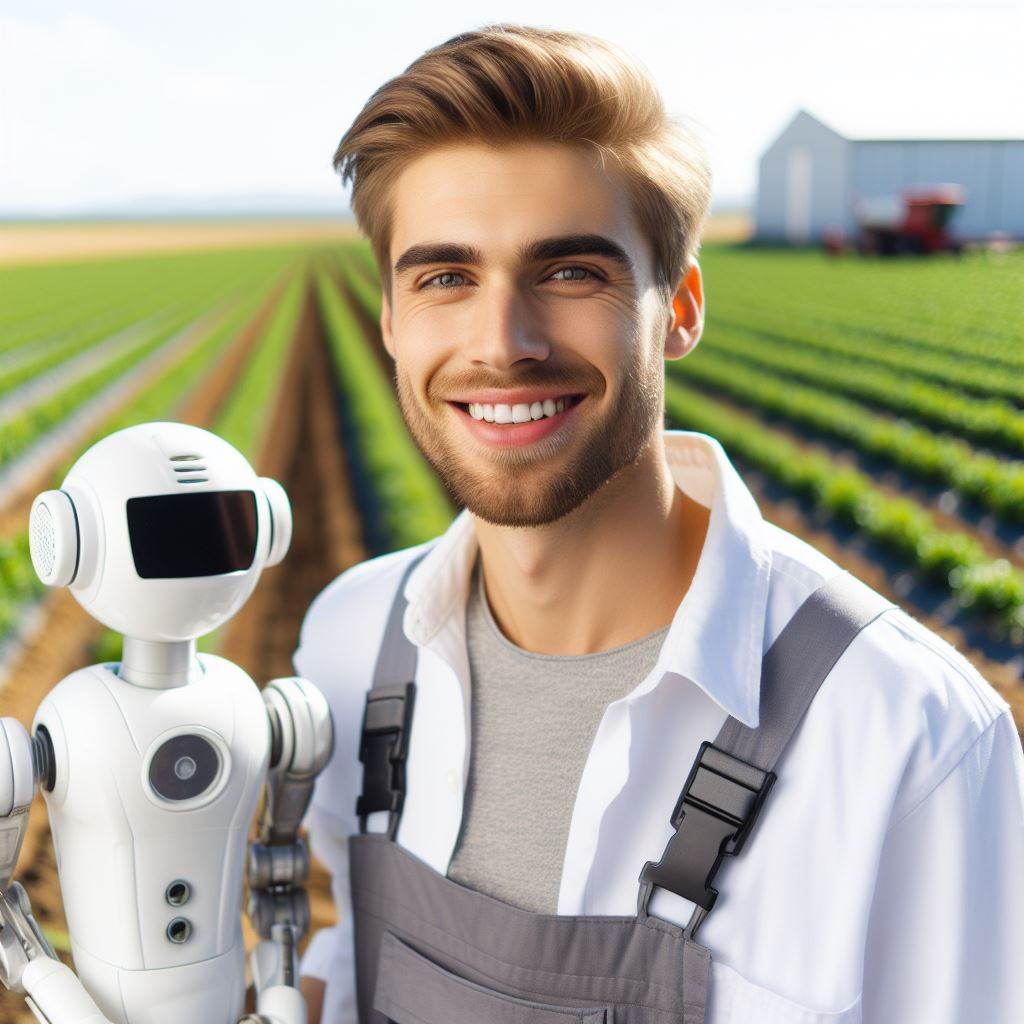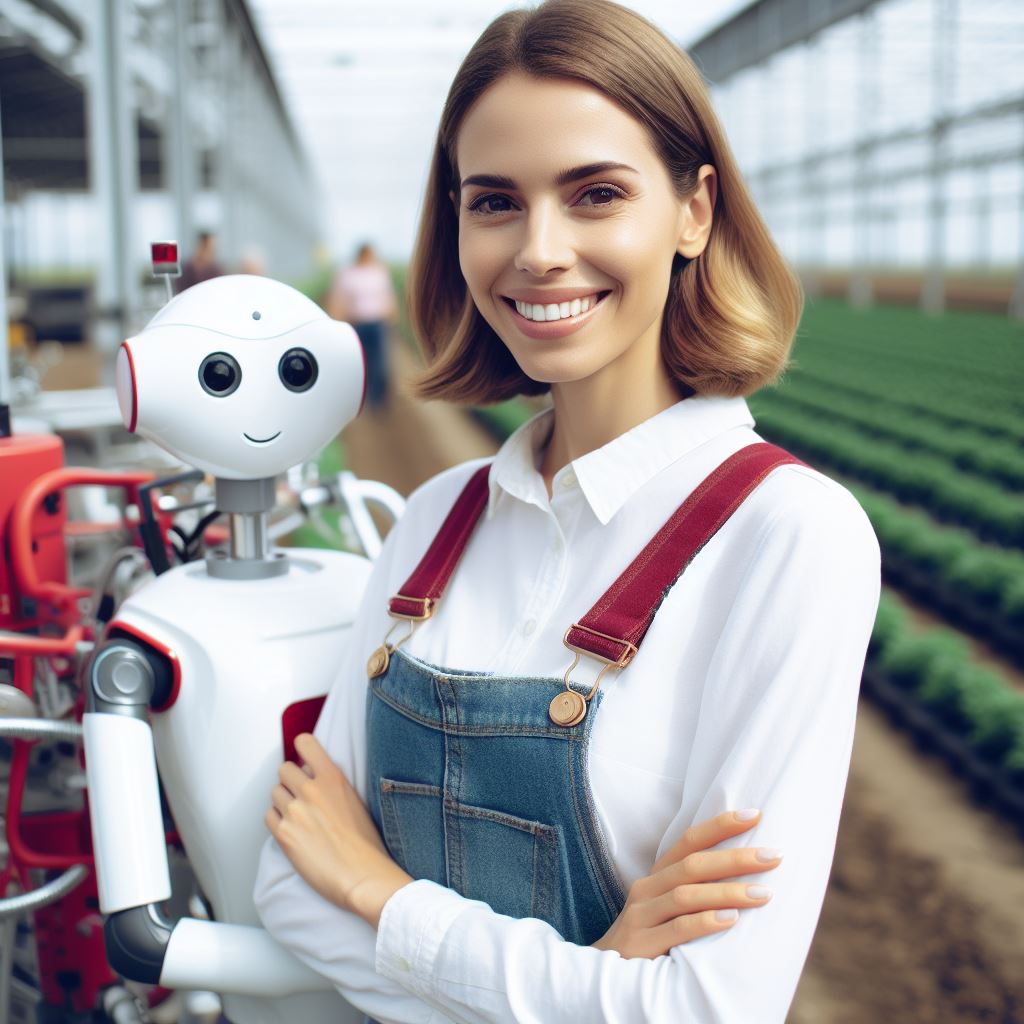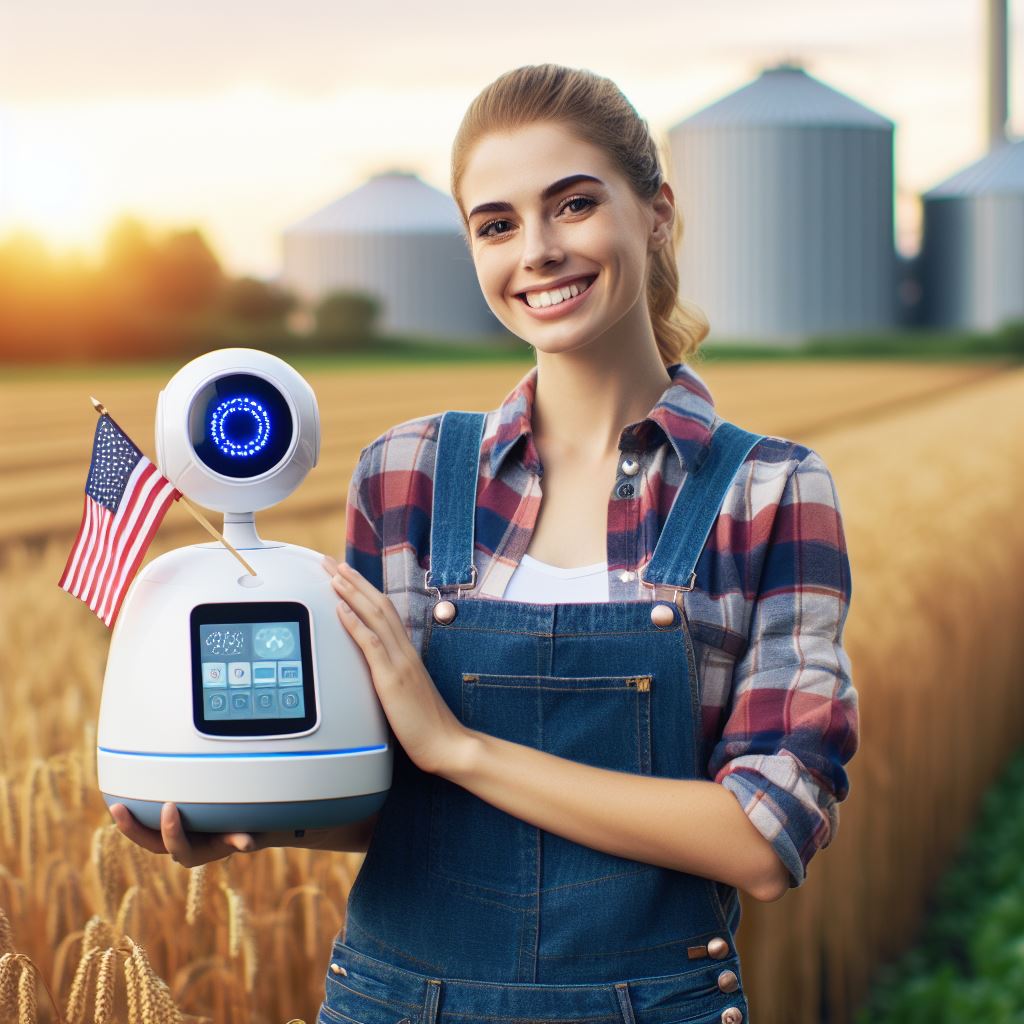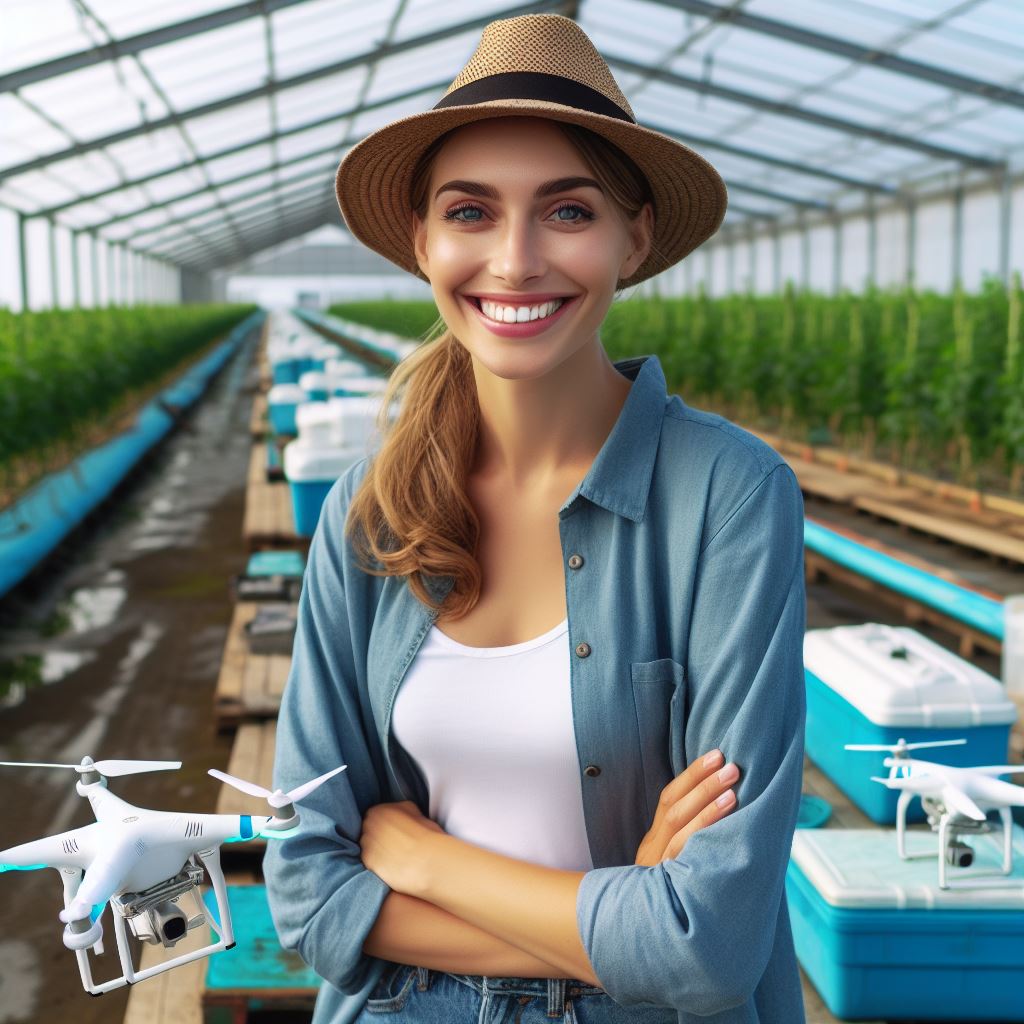Introduction
In today’s agriculture, technology plays a crucial role in enhancing efficiency, productivity, and sustainability.
Robotic technology, particularly, has emerged as a game-changer.
With advancements in artificial intelligence and robotics, farmers can automate various tasks, from planting and harvesting to monitoring crop health.
Exploring robotic technology in agriculture is significant for unlocking new possibilities, addressing labor shortages, and meeting the growing demand for food sustainably.
As we delve deeper into the realm of robotic tech in agriculture, we’ll uncover its potential to revolutionize farming practices and shape the future of food production.
Join us on this deep dive into the innovative world of robotic technology in agriculture, where science fiction meets agricultural reality.
History of Robotic Technology in Agriculture
Historically, the development of robotic technology in agriculture has been groundbreaking and impactful.
In its early stages, robotics made significant advancements and achieved important milestones that shaped the field.
Moreover, there were several early applications of robots in farming that showcased their potential and effectiveness.
During the 1970s and 1980s, the first robotic technologies started to emerge in agriculture. In these early stages, robots were primarily used for simple and repetitive tasks, such as crop spraying and harvesting.
These robots were equipped with sensors and programmed to perform specific actions in the field.
One significant milestone in the history of robotic technology in agriculture was the development of the “Shakey” robot in the late 1960s.
Shakey was designed to navigate through a complex environment using artificial intelligence and computer vision algorithms.
While not specifically used in agriculture, Shakey’s developments laid the foundation for future advancements.
Advancements and milestones in the field
Advancements in robotic technology continued throughout the years, with increased capabilities and applications.
In the 1990s, robots equipped with imaging systems were introduced.
These robots could identify and remove weeds with precision, reducing the need for harmful herbicides.
Another milestone was the introduction of autonomous tractors.
These vehicles could navigate the fields on their own, while also performing tasks like plowing, sowing seeds, and applying fertilizers.
This innovation significantly increased the efficiency and productivity of farming operations.
Examples of early robot applications in farming
Early robot applications in farming showcased their potential to revolutionize the industry.
For instance, milking robots were developed to automate the milking process in dairy farms.
These robots could identify and attach to cows’ udders, ensuring a hygienic and efficient milking process.
Similarly, robots were used for fruit picking, a task that traditionally required intensive manual labor.
Robotic fruit pickers could identify ripe fruits, gently harvest them without damage, and sort them based on size and quality.
This automation improved the efficiency of fruit harvesting while also reducing costs.
Robots also found applications in monitoring and data collection on farms.
Remote-controlled drones equipped with sensors and cameras could survey large areas of farmland, identifying crop health, detecting pests, and providing farmers with valuable insights.
In recent years, robotic technology in agriculture has continued to advance rapidly.
The introduction of machine learning and artificial intelligence has enhanced robots’ capabilities, allowing them to make autonomous decisions based on real-time data.
This has led to the development of robots that can perform complex tasks like selective harvesting and precision crop management.
Additionally, robots are being used for indoor farming, where controlled environments optimize crop growth.
These robots can monitor and adjust environmental conditions, ensuring ideal growing conditions for plants.
Basically, the history of robotic technology in agriculture has been characterized by significant developments and milestones.
From early applications in crop spraying and harvesting to the introduction of autonomous tractors and advanced robotics, the field has undergone remarkable transformations.
With the continuous advancements in technology, robots are set to play an increasingly important role in the future of farming, significantly improving productivity, efficiency, and sustainability.
Read: Next-Gen Farming: The Role of Drones
Current Applications of Robotic Technology in Agriculture
In recent years, the use of robotic technology in agriculture has experienced significant growth and development.
Farmers and researchers are embracing these advancements, recognizing the potential benefits they bring to the industry.
Let’s take a deep dive into the current applications of robotic tech in agriculture:
Use of robots in planting and seeding
- Robotic planting and seeding systems are increasingly being used to automate the process.
- These robots can accurately and efficiently sow seeds in fields, saving time and labor.
- They ensure precise placement of seeds, optimizing the growth and overall yield of crops.
Robotic solutions for crop monitoring and data collection
- Robots equipped with advanced sensors are used to monitor crops and collect valuable data.
- They can detect diseases, pests, and nutritional deficiencies that may affect plant health.
- This data enables farmers to implement timely interventions, reducing crop losses and improving yield.
Application of robots in harvesting and picking
- Robotic harvesters and pickers have revolutionized labor-intensive tasks in agriculture.
- These machines can efficiently harvest fruits, vegetables, and crops at a faster pace.
- They ensure gentle handling of delicate produce, minimizing damage and reducing product loss.
Robotics in precision agriculture and resource management
- Robotic technology plays a crucial role in precision agriculture and resource management.
- Robots equipped with GPS and remote sensing technologies can provide accurate mapping and monitoring.
- They help optimize the usage of water, fertilizers, and pesticides, enhancing sustainability.
The integration of robotics in agriculture brings numerous advantages to farmers and the environment.
Let’s explore some of these benefits:
Transform Your Agribusiness
Unlock your farm's potential with expert advice tailored to your needs. Get actionable steps that drive real results.
Get StartedIncreased efficiency and productivity
Robots can perform tasks with higher speed and precision compared to manual labor.
This results in increased efficiency and productivity for farmers.
Automated processes such as planting, seeding, and harvesting reduce human error and save valuable time.
Cost savings
The use of robots reduces labor costs associated with hiring and managing a large workforce.
While robotic technology requires an initial investment, the long-term cost savings outweigh the upfront expenses.
Additionally, robots reduce the dependency on seasonal workers, who may not always be readily available.
Improved crop quality
Robotic solutions contribute to improved crop quality by ensuring consistent and accurate operations.
Precise planting and seeding lead to uniform growth and healthier plants.
The timely detection of diseases and pest infestations allows for targeted treatments, minimizing crop damage and ensuring high-quality produce.
Environmental sustainability
Robotic technology promotes sustainable agricultural practices.
With precise data collection and monitoring, farmers can optimize the use of resources.
This reduces unnecessary applications of water, fertilizers, and pesticides, minimizing the environmental impact.
Additionally, robots can operate autonomously using clean energy, further reducing carbon emissions.
As the agricultural industry continues to evolve, robotic technology will play an increasingly integral role.
The current applications we’ve explored are just the beginning. With advancements in artificial intelligence and machine learning, the possibilities for robotics in agriculture are limitless.
Farmers can look forward to increased efficiency, improved yields, and a more sustainable future.
Read: Tech Trends: AI & Crop Management

Benefits of Robotic Technology in Agriculture
Robotic technology is revolutionizing the agricultural sector and offering numerous benefits:
Improved Efficiency and Productivity
- Robots can automate repetitive tasks, allowing farmers to focus on more complex activities.
- They can work 24/7 without the need for breaks, resulting in higher productivity.
- Efficiency is increased as robots can complete tasks faster than human labor.
Reduction in Labor Costs and Dependence
- With robots taking over labor-intensive jobs, farmers can reduce labor costs significantly.
- Robots eliminate the need for seasonal labor and reduce dependence on human workers.
- Investing in robotic technology provides long-term cost savings for farms and agricultural businesses.
Enhanced Accuracy and Precision in Tasks
- Robots are programmed to perform tasks with high precision, preventing errors.
- They can precisely apply pesticides, herbicides, and fertilizers, reducing wastage and saving costs.
- Robots can collect data with sensors and cameras, providing accurate information for decision-making.
Minimization of Environmental Impact
- Using robots in agriculture reduces the environmental impact of farming practices.
- Robotics reduces the need for excessive use of chemicals, promoting sustainable farming.
- Robots can perform precision farming, optimizing resource utilization and minimizing waste.
Potential for Increased Crop Yields and Quality
- Robots can monitor crops continuously, identifying and addressing issues promptly.
- They can provide precise irrigation, improving water utilization efficiency.
- Robots can selectively harvest crops based on their readiness, ensuring high-quality produce.
In fact, the integration of robotic technology in agriculture offers several benefits.
It improves the efficiency and productivity of farms, reduces labor costs and dependence, and enhances accuracy and precision in various tasks.
Furthermore, the environmental impact of farming is minimized through optimized resource utilization.
The potential for increased crop yields and improved product quality further highlights the advantages of robotic technology in agriculture.
Read: Drone Imaging in Farms: A New Perspective
Challenges and Limitations of Robotic Technology in Agriculture
While robotic technology has the potential to revolutionize the agricultural industry, it also faces several challenges and limitations that need to be addressed for widespread adoption.
Some of these challenges include:
High initial costs and returns on investment
Implementing robotic technology in agriculture requires a substantial upfront investment, which can be a barrier for many farmers.
Additionally, determining the return on investment for such technology is complex and uncertain.
Complex technology integration and implementation
Integrating robotic technology into existing agricultural systems can be a difficult and time-consuming process.
The compatibility of robots with different machinery and software systems needs to be carefully considered.
Potential job displacement and Social Impacts
The use of robots in agriculture could lead to job displacement for many workers.
This could have significant social and economic impacts on communities that rely on agriculture for employment.
Limited adaptability to diverse agricultural environments
Robotic technology may not be adaptable to all types of agricultural environments.
For example, terrains with uneven surfaces or dense vegetation may pose challenges for robots to navigate and operate effectively.
Addressing these challenges and limitations will be crucial for the successful integration of robotic technology in agriculture.
Strategies that can help overcome these obstacles include
Cost-effective solutions and financial support
Providing farmers with affordable options for implementing robotic technology, such as subsidies or financing programs, can help reduce the initial investment costs and encourage adoption.
Collaborations and partnerships
Creating partnerships between technology providers, agricultural experts, and farmers can help streamline the integration and implementation process.
These collaborations can facilitate knowledge sharing and provide guidance on adapting robotic technology to diverse agricultural environments.
Training programs and reskilling initiatives
Developing training programs to equip farmers with the necessary skills to operate and maintain robotic technology is essential.
Additionally, offering reskilling initiatives for workers who may be displaced by robots can help mitigate the social impacts of job loss.
Continuous innovation and adaptation
Investing in research and development to improve the adaptability of robotic technology in diverse agricultural environments is crucial.
This includes developing robots that can efficiently operate in challenging terrains and overcome obstacles.
In short, while there are challenges and limitations associated with robotic technology in agriculture, they can be overcome through strategic approaches and collaboration.
By addressing these challenges, the agricultural industry can benefit from increased efficiency, reduced labor requirements, and improved sustainability.
Read: Farming Apps: Top Picks for 2024
Future Trends and Potential of Robotic Technology in Agriculture
The field of robotic technology in agriculture has experienced remarkable advancements in recent years.
With the integration of artificial intelligence (AI) and machine learning, robots are becoming more capable of performing complex tasks in farming operations.
One of the notable trends in this field is the use of drones and sensors in agricultural robotics.
Drones equipped with cameras and sensors can collect data on crop health, soil conditions, and pest infestations, allowing farmers to make informed decisions and optimize their farming practices.
Furthermore, the integration of AI and machine learning algorithms enables robots to analyze the collected data and make autonomous decisions.
This technology empowers robots to identify and selectively target specific plants for fertilization or pesticide application, minimizing the use of resources and reducing environmental impact.
Showcase Your Farming Business
Publish your professional farming services profile on our blog for a one-time fee of $200 and reach a dedicated audience of farmers and agribusiness owners.
Publish Your ProfileAs technology continues to advance, the potential for robotic solutions in livestock farming is also expanding.
Robotic milking systems have already been successfully implemented in dairy farms, improving efficiency and reducing labor costs.
These systems can automatically detect when a cow needs to be milked and perform the task without human intervention.
Additionally, robots are being developed to handle other tasks in livestock farming, such as feeding, monitoring animal health, and even sorting animals for specific purposes, such as breeding or medical treatment.
These advancements are revolutionizing the agricultural industry by increasing productivity and reducing the need for manual labor.
Role of robotics in sustainable and organic farming practices
In the realm of sustainable and organic farming practices, robotics plays a crucial role.
With the growing demand for organic produce and environmentally friendly farming methods, robots provide a viable solution.
They can precisely apply fertilizers and pesticides, ensuring minimal wastage and preventing chemicals from polluting soil and water sources.
Robotic technology also enables precision agriculture, where farmers can precisely control irrigation, monitor crop growth, and manage resources efficiently.
This level of precision reduces water consumption, decreases the use of chemical inputs, and optimizes crop yields. It contributes to the overall sustainability of agricultural practices.
Furthermore, robots can be programmed to perform repetitive and physically demanding tasks, eliminating the need for human labor in hazardous conditions.
This not only enhances worker safety but also allows farmers to allocate human resources to more skilled and strategic roles.
In essence, the future of robotic technology in agriculture looks promising.
Advances in AI and machine learning, coupled with the integration of other emerging technologies, are revolutionizing farming practices.
From crop monitoring to livestock management, robots are reshaping the industry by increasing efficiency, reducing environmental impact, and promoting sustainable and organic farming methods.
Conclusion
Robotic technology in agriculture offers numerous benefits and challenges.
The use of robots can increase productivity, reduce labor costs, and improve precision in farming operations.
However, there are challenges related to high initial investment and the need for specialized training.
Further research and development are essential to overcome these challenges and unlock the full potential of robotic technology in agriculture.
Continued innovation can lead to the development of more advanced and efficient robots that can perform complex tasks efficiently.
The transformative impact of robots in farming cannot be underestimated.
With robots, farmers can achieve higher crop yields, optimize resource utilization, and promote sustainable practices.
Robotic technology can also facilitate data collection and analysis, enabling farmers to make data-driven decisions for improved farm management.
Overall, the future of agriculture lies in the integration of robotics and automation.
While challenges exist, the benefits and potential transformative impact make it worth investing in robotic technology for the agricultural sector.
By embracing robots, farmers can boost productivity, profitability, and sustainability, ensuring a more secure future for the industry.




